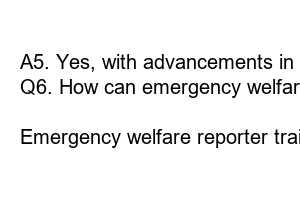긴급복지 신고의무자 교육
Title: Emergency Welfare Reporter Training: Preparing For Crisis Response
Introduction:
In times of crisis, such as natural disasters or public emergencies, the need for efficient and reliable emergency welfare reporters becomes paramount. These dedicated individuals play a crucial role in gathering and disseminating vital information, ensuring that affected communities receive the necessary support and assistance. To meet these demanding challenges, emergency welfare reporter training programs have emerged as instrumental platforms. In this blog post, we will explore the significance of such training, its key components, and the positive impact it can have on crisis response efforts.
1. Understanding the Role of Emergency Welfare Reporters:
Emergency welfare reporters serve as the liaison between affected communities and relief organizations, government agencies, and the general public. They are responsible for accurately reporting on the immediate needs of the affected population, while also highlighting the progress of relief efforts. Their reports play a pivotal role in mobilizing resources, coordinating rescue operations, and providing crucial information to decision-makers.
2. Comprehensive Training for Effective Crisis Coverage:
To ensure exceptional performance in high-pressure situations, emergency welfare reporter training programs focus on various key aspects, including crisis communication, ethical reporting, trauma-informed reporting, and community engagement. Courses cover topics such as effective interviewing techniques, cultural sensitivity, conflict resolution, and crisis management strategies. By honing these skills, reporters can provide accurate and empathetic coverage that complements relief efforts.
3. Practical Simulation Exercises:
One crucial aspect of emergency welfare reporter training is practical simulation exercises. These exercises simulate real-world crisis scenarios, allowing trainees to experience the challenges they may encounter firsthand. Through these simulations, trainees learn to effectively navigate chaotic environments, make quick decisions, and prioritize information dissemination in time-sensitive situations.
4. Emphasizing Personal Safety and Self-Care:
While reporting on emergencies, the safety and well-being of reporters should never be compromised. Training programs prioritize personal safety by educating reporters on risk assessment, personal protective measures, and the identification of potential hazards. Additionally, self-care techniques are taught to alleviate stress and trauma experienced in challenging situations.
5. Building Networks and Collaborative Relationships:
Effective crisis response requires strong partnerships and collaborative efforts. Emergency welfare reporter training programs facilitate connections between reporters, emergency management teams, relief organizations, and local authorities. By fostering these relationships, reporters gain access to valuable resources, enhance their understanding of local contexts, and contribute to a cohesive crisis response strategy.
6. Accountability and Ethical Reporting:
Emergency welfare reporter training emphasizes the importance of ethical journalism, ensuring accurate and responsible reporting. Reporters are trained to prioritize the privacy and dignity of affected individuals, respecting cultural and legal boundaries. Moreover, training programs promote transparency and accountability, fostering trust between reporters and the communities they serve.
FAQs (Frequently Asked Questions):
Q1. How long does emergency welfare reporter training typically last?
A1. The duration of training programs can vary, but most courses range from a few days to a few weeks, depending on the depth of the curriculum.
Q2. Can anyone participate in emergency welfare reporter training?
A2. Yes, individuals with a background in journalism, communication, or humanitarian work are encouraged to participate. However, passion, dedication, and a commitment to ethical reporting are the most important qualities.
Q3. Are there any certifications available upon completion of training?
A3. Yes, many training programs offer certifications that validate the acquired skills and demonstrate a commitment to professional and ethical reporting during crises.
Q4. Is emergency welfare reporter training only focused on natural disasters?
A4. No, while natural disasters are a significant focus, emergency welfare reporter training also covers public health emergencies, conflict situations, and other crises that require immediate attention.
Q5. Can these training programs be conducted online?
A5. Yes, with advancements in technology, many training programs offer online options, allowing participants to access the courses from anywhere in the world.
Q6. How can emergency welfare reporter training benefit communities?
A6. Training reporters ensures accurate and empathetic coverage, enabling relief organizations to deploy resources effectively and swiftly meet the needs of affected communities.
Summary:
Emergency welfare reporter training plays a vital role in enhancing crisis response efforts. By equipping reporters with the necessary knowledge, skills, and ethical guidelines, these programs facilitate accurate and empathetic reporting during emergencies. Through comprehensive training, practical exercises, collaboration opportunities, and an emphasis on ethical reporting, emergency welfare reporters become invaluable assets in providing timely and vital information to affected communities, ultimately contributing towards more efficient and effective crisis management.

